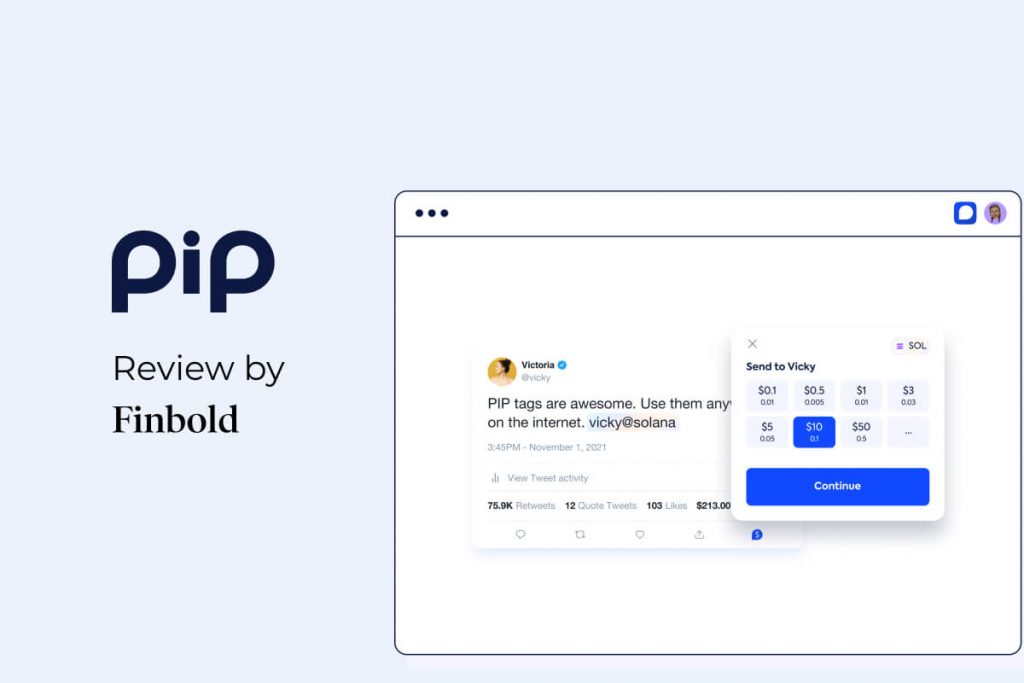About PIP
PIP is a web application launched in August 2021 that adds Web3 functionality onto traditional Web2 properties such as Facebook, Twitter, Twitch, and Medium, enabling users to buy and sell crypto assets directly on these platforms.
Take, for instance, a blogger on the Medium website; they could use PIP to set up paywalls and accepts payment in SOL, PIP, SRM, USDC, RAY, and FIDA tokens directly without using an intermediary.
The crypto payments service promises to disrupt the current online payments landscape dominated by companies such as PayPal and Stripe and increase economic freedom globally by empowering individuals.
To enable self-custody and autonomous payment processing, PIP works with self-hosted wallets such as Phantom or Slope wallets, two of the leading Solana-based crypto wallets. As a result, PIP can process transactions for token and NFT (non-fungible token) transfers in a peer-to-peer fashion.
Why do people use PIP?
PIP appeals to its prospective and current users because of the following reasons:
- Innovative features – PIP offers its users multiple products and services necessary to enable seamless and straightforward Web3 payments on traditional Web2 platforms;
- Convenience – PIP currently does not have a direct competitor, but it rivals a few other more prominent traditional solutions, including PayPal and Stripe. The two products are not only expensive to use, but also less convenient as they are highly regulated and must adhere to various jurisdictional restrictions. PIP, on the other hand, is open to everyone across the world, it is cheap to use, and transactions are settled almost instantaneously;
- Peer-to-peer – there is no intermediary to process transactions on the PIP network as the product is designed to get rid of exploitative intermediaries. This, in effect, makes transactions much faster and cheaper;
- Cost-effective – PIP faces little direct competition within the cryptocurrency space but compared to other Web2 solutions, the application is fast and cheap. The project is created on top of the nascent Solana ecosystem, a highly scalable layer-1 blockchain network with support for smart contracts and decentralized applications (dApps). The network is able to process transactions at a rate of 1,500-2,500 transactions every second but, theoretically, can process as many as 700,000+ TPS. The fast speeds contribute toward lowering the network fees since users do not have to outcompete one another in price bids for validators to verify their transactions;
- Novel innovation – PIP introduces a novel idea in which anyone can make and receive crypto payments on their content or content they consume on social media platforms such as Facebook, Twitter, and Twitch. The idea is simple and interesting enough to attract a large user base to make the business viable.
PIP key products
PIP provides three key solutions through its suite of current and future products. The solutions are:
- Facilitating value transactions using cryptocurrencies in a peer to peer manner;
- Linking social identity to crypto-ownership;
- Empowering content creators to monetize their content online on Web2 and 3 platforms.
To achieve these goals, here are some of the products that the company has launched so far:
- PIP.me;
- PIP Extension;
- PIP Tag (coming soon);
- PIP Token.
Let’s consider each product in further detail.
1. PIP.ME
The PIP.ME feature is a Web3 profile management function offered by PIP enabling users to accept payments online and connect to the audience while avoiding pseudonyms.
It is essentially a profile link or tag that you can post anywhere to enable someone else to identify you and make a payment to your cryptocurrency wallet.
PIP.ME is powered by Solana Pay, through which the payments are processed, and according to the PIP website, payments on the PIP.ME service is free. Additionally, the service also supports mobile wallets and QR payments.
2. PIP browser extension
The PIP browser extension is the interface through which PIP users interact with the various features. It is supported on Google’s Chrome, and Chromium-based browsers such as Brave, Microsoft Edge, and Opera.
Once the extension has been installed on a browser, it can automatically detect when the user is accessing a supported social media platform such as Twitter. It, therefore, scans for any payment buttons on the page.
Note: PIP is only available on the desktop version at the moment; therefore, it can only be used whilst accessing the web versions of the social media websites.
3. PIP Tag
PIP Tags are easy-to-understand wallet addresses that make payments easy and less error-prone. Instead of using the typical public wallet addresses that comprise multiple alphanumeric characters, the user can opt for the PIP tag with human-readable phrases such as sam@pip or rachel@solana.
PIP tags are easy to create and can be shared anywhere on the internet to enable easy payments. Additionally, the Tags can be used on social media platforms that are not yet supported by PIP.
To use a PIP tag, hover over it whenever it is displayed to activate the payment dialog box. It works in conjunction with the PIP browser extension.
4. PIP Token
PIP offers a Solana-based native utility token dubbed PIP Token (PIP) that serves multiple functions, including:
- Value transfer – PIP tokens can be sent and received as payment for goods and services offered;
- Reward farming – PIP enables its browser extension users to earn rewards in PIP tokens for engaging with the ecosystem;
- Governance – PIP token holders are automatic members of the PIPDAO (decentralized autonomous organization) whose membership is responsible for making governance decisions about the ecosystem;
- Staking rewards – PIP incentivizes its community members to provide liquidity by rewarding them with PIP tokens depending on their staking contributions to a liquidity pool.
The PIP tokens have a total supply of 1,000,000,000 distributed amongst four diverse groups:
- Community treasury: 69%
- Strategic investors: 15%
- Team: 15%
- Advisors: 1%
The team has implemented a vesting period provision to ensure that tokens are slowly released into the marketplace, thus preventing dumbing effect, which typically depresses the price.
Additionally, vesting ensures that some of the core team members are incentivized to participate within the community long enough to assure the stability of the growing startup.
Cost of using the PIP Service
The PIP project has a simple value proposition – to enable users to make and receive crypto payments and transfer other digital assets among each other.
So far, PIP charges a processing fee of 1% of the value of all transactions carried out on its platform, plus it levies a $10,000 listing fee for other projects that wish to be incorporated into the PIP ecosystem. The latter is a fee that only applies to other project developers and thus excludes users.
Is the PIP service safe?
PIP is a safe platform to manage your cryptocurrency assets, and this is due to several reasons, which include:
- Fostering self-custody. PIP partners with reputable wallets to ensure the security of its users’ assets. Self-custody means that the users are responsible for securing their crypto, but PIP has made this exercise more accessible by providing integration with Phantom and Slope wallets, two of the leading Solana-based crypto wallets;
- Inherited security – the PIP browser extension has been deployed on highly reputable and popular platforms, including Google’s Chrome which maintains strict listing policies for all applications running on its platform. Additionally, the extension has integrated with Phantom and Slope to offer wallet services for PIP users. They undergo regular audits and maintain active bug bounty programs to ensure that their applications are safe. PIP inherits these security benefits through its association with them;
- Reputation – the PIP project may be relatively new to the marketplace, but it does launch with a lot of notable investors and advisors backing it. The list includes Coinbase Ventures, an investment arm of the US’s leading crypto exchange; Alameda Research, the company behind the popular FTX platform; and Galaxy Digital, a New York-based cryptocurrency asset management firm, among others.
PIP’s customer support
The PIP project has grown to host a vibrant community of users, team members, and other stakeholders. Any questions from beginners and other community members can be addressed by fellow stakeholders who are available across most of the leading social media platforms, including:
Outside the social media platforms listed above, there are other channels to get the appropriate help and customer support. These are:
- The GetPIP website – hosts a bunch of helpful user guides and an FAQ section with some of the most common questions;
- Email – the PIP team is available through email;
- GitBook repository – holds a knowledge base section with articles on how to use PIP, feature tutorials, comprehensive guides, and product announcements.
How to start using PIP for Payments (step-by-step)
The following tutorial will outline the necessary steps involved before you can start using PIP. The main product being the browser extension, this guide will show you step-by-step by to download it, install and begin using it.
Step 1 – Visit the PIP website.
Navigate to the PIP website at www.getpip.com. Click on either of the two [Add to Chrome] buttons as shown below. If you scroll further down, there are more buttons you can use once you read through the page.
Clicking on any of the buttons above will redirect you to the Google Chrome browser extension page, where you can download the extension to your browser.
Note: PIP extension is only supported on desktop versions of Chrome/Brave, Opera, and Edge browsers; therefore, ensure that you are following along with this tutorial using any of these browsers.
Step 2 – Install the PIP Extension.
On the extension installation page, click the [Add to Chrome] button to download and install it.
Next, approve the installation by accepting to download the extension. On the popup dialog box, click [Add extension].
The plugin will download and install automatically. Once done, a small icon will be displayed on the top right corner of the browser window next to the address bar.
Step 3 – Install Phantom Wallet.
You will need the Phantom wallet to execute any transactions on the PIP application. Therefore, visit the Phantom download page to install the wallet. (Alternatively, you can install Slope wallet instead of Phantom.)
Click on the appropriate icon representing the browser on which you are installing the PIP extension. This will redirect you to the Chrome plugin extension download page for Phantom Wallet.
Next, click on the Phantom icon to open the wallet interface, where you will then create a new wallet or log in if you already have an account with the Phantom wallet.
Create a strong password and ensure you safely back up your wallet recovery phrase. Once you do, you are ready to activate the PIP extension.
Step 4 – Activate the PIP Extension.
Click on the PIP extension icon on the top right of the browser window to launch the application.
Select either of the two wallet options provided. In our case, we have opted to connect Phantom because that is the wallet we installed in the previous step. After clicking on your preferred option, PIP will send a connection request to the wallet extension, and a popup window will appear.
Provide your authorization that you wish to connect PIP to Phantom by clicking on the [Connect] button.
An additional verification prompt will appear requesting you to confirm your approval. Click [Approve] to continue.
You have successfully connected PIP to Phantom at this stage, but there are a few extra steps to set up your PIP extension. The Phantom popup window will disappear at this point, and you will be redirected back to the PIP extension dialog window.
Click the [Get Started] button to finish setting up the application.
Next, provide a unique identifying tag or username to identify your account.
The PIP Tag will be used the same as the public wallet or email address. You can share it anywhere with anyone who wishes to send funds to you. However, it is only connected to PIP, so it cannot be used for payments outside the PIP ecosystem.
Click [Confirm] to register your PIP tag (username).
Next, connect your social media pages or skip and revert to this step at a later time. If you prefer to connect your accounts, click on the chainlink icons highlighted below. Currently, four social media networks are supported.
You have successfully installed and activated your PIP browser extension. Now you start making payments to other PIP users on social media or use your PIP Tag to receive payments.
To start making payments, visit any of the supported social media pages, navigate to a user’s profile page and click on the ‘Dollar’ button to display various denominations available to send.
If the receiver is not a PIP user, they have a 24-hour window to install PIP, activate it, and claim their payment. Otherwise, the funds will be returned to the initiating wallet after the allowed time period has lapsed.
Pros & Cons of using PIP

Pros
- PIP is convenient to use;
- Costs of sending and receiving payments are low;
- Since PIP is based on Solana, transactions take seconds to execute;
- The platform is highly secure;
- The PIP extension is free to use;
- PIP supports most of the leading social media apps such as Twitter, Reddit, and Twitch;
- There is support for multiple assets with provision for more;
- PIP is censorship-resistant;
- The application allows users to earn extra income through the reward farming program and staking.

Cons
- There is currently a limited selection of assets and social media platforms supported;
- The PIP platform is relatively new compared to its conventional rivals, including PayPal and Stripe, which are also more popular.
Final thoughts
Cryptocurrencies are slowly becoming more mainstream, and applications such as PIP are proving to be instrumental in bridging the gap between the conventional Web2 world with the new blockchain-based world, also called Web3.
PIP offers a simple solution whereby users can send and receive crypto payments on social media platforms. They can also share crypto assets such as NFTs, among others.
So far, PIP enjoys the first-mover advantage with few, if any, direct rivals within the blockchains space.
The main competition the service aims to disrupt is the conventional payment processing services, including PayPal and Stripe. They may be stalwarts in the financial industry, but with the increasing adoption of the nascent blockchain technology, the landscape may change in favor of PIP.
FAQs on PIP
What is PIP?
PIP is a web-based application that introduces Web3 functionality onto traditional social media platforms such as Facebook, Twitter, and Reddit, enabling easy crypto payments and digital asset transfers amongst users.
How can I use PIP?
There are four easy steps to using PIP:
- Install PIP browser extension;
- Activate the extension by connecting to a supported wallet such as Phantom App;
- Connect your social media profiles to PIP;
- Start sending and receiving crypto payments.
What is ‘Reward Farming’?
Reward farming is an exercise in which PIP users are rewarded for engaging within the PIP ecosystem using the browser extension.
How can I use the PIP token?
The PIP token is a Solana-based utility asset serving three main purposes within PIP:
- It can be used for reward farming;
- PIP token holders are considered members of the PIPDAO and can participate in the governance of the platform;
- It can be used to earn staking rewards for those that opt to provide liquidity within the common PIP liquidity pool.




